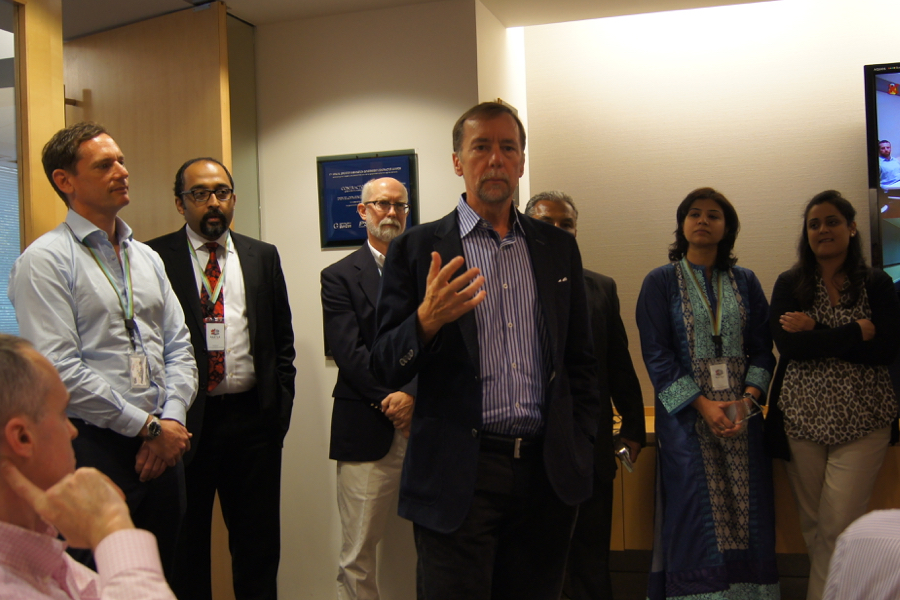DEVELOPMENTS
Stepping Up to the Innovation Challenge
Dec 16, 2014
On the morning of October 29, a panel of distinguished judges gathered in Bethesda, Maryland, to hear the final pitches from five DAI projects competing for the title of DAI “Innovation of the Year.”
They heard powerful, impassioned cases made by project staff working to improve education in Pakistan, facilitate land titling in Ethiopia, recognize the land rights of indigenous people in Honduras, and mitigate the effects of climate change in the Pacific Islands.
The proceedings were broadcast live to DAI staff by videoconference, and at a lunch-time celebration the Transforming Education in Pakistan project’s online clearinghouse for education data was named the winner.
The announcement marked the culmination of a five-month Innovation Challenge that is the focal point for this issue of Developments.
Our focus on innovation is occasioned in large part by our clients, whose renewed emphasis on driving beyond the status quo is embodied in new institutions such as the U.S. Global Development Lab and the Global Innovation Fund. Jeson Ingraham’s article discusses these and other donor initiatives to spur new thinking and engage new partners in the development enterprise.
Part of our own response to such initiatives, the Innovation Challenge has proved to be a rewarding and enlightening process, as Betsy Marcotte documents in her lead article on the “lessons and legacy” of the exercise. We have learned about what we are doing within our own network (no small challenge in a globally dispersed organization) and what we can do better to capture, refine, and share the fruits of creativity across that network and beyond.

Such insights are important for an organization that likes to think of innovation as part of its DNA. Ever since the founders named the company Development Alternatives, Inc.—signifying their commitment to offer fresh, “alternative” solutions to development problems—we have sought to live up to that promise. And while the response to the Challenge (92 submissions from 53 projects) suggests that their legacy lives on, there is no appetite for complacency: both Marcotte and Jeremy Kanthor, in his piece on innovation fatigue, acknowledge the difficulties of nurturing innovation and integrating it into the daily round of designing, managing, and delivering effective development programming.
Brigit Helms, a leading DAI thinker on innovation and “intrapreneurship,” takes up this increasingly pressing question of how to institutionalize innovation in her article, “Can the development set reinvent itself?”
As Helms points out, the processes of innovation should never be limited to—or cordoned off within—one-off initiatives such as prizes or contests. Our own Innovation Challenge—modeled in part on the Grand Challenges for Development methodology we have been supporting in work for the U.S. Agency for International Development—is just one of various initiatives under way to ensure DAI is responding to the innovation mandate. And it remains to be seen how well we can integrate it into the fabric of DAI’s technical work. But it was sufficiently successful that we are already iterating a follow-up for next year, with an emphasis on more timely and direct ways to channel staff ideas into DAI proposals, designs, and project work.
Finally, complementing these reflections on the Innovation Challenge is a collection of innovation-themed articles by DAI staff and other authors:
- Brigit Helms makes the case that the field of financial inclusion is ripe for disruption;
- Jessica Heinzelman and Mike Rios, Chief Innovation Officer at 17 Triggers, call for more “design thinking” in development;
- Rios and Sam Ng further argue that “failing fast” is a private-sector principle that development practitioners would do well to emulate;
- Robert Ryan-Silva, Director of the DAI Maker Lab, discusses how the emerging “maker movement” has much to offer international development, perhaps especially in technology transfer;
- Kristen Roggemann and Nathan Eagle, CEO of Jana, broach the subject of harnessing “big data” for development impact, while John Maris explores in depth how big data could be brought to bear in the particular discipline of humanitarian relief operations;
- Guy Stuart, Executive Director of Microfinance Opportunities, and Jorrit de Jong and Linda Kaboolian, who teach at Harvard University, make a plea for “embedded education;” and
- John DeRiggi asks whether airborne drones could have a bigger role to play in development generally, while Patrick Meier—Director of Social Innovation at QCRI—shows how they are already a significant factor in disaster response.
We hope that this issue of Developments will be of use to others in the development community as we collectively consider how best to step up to the innovation challenge.